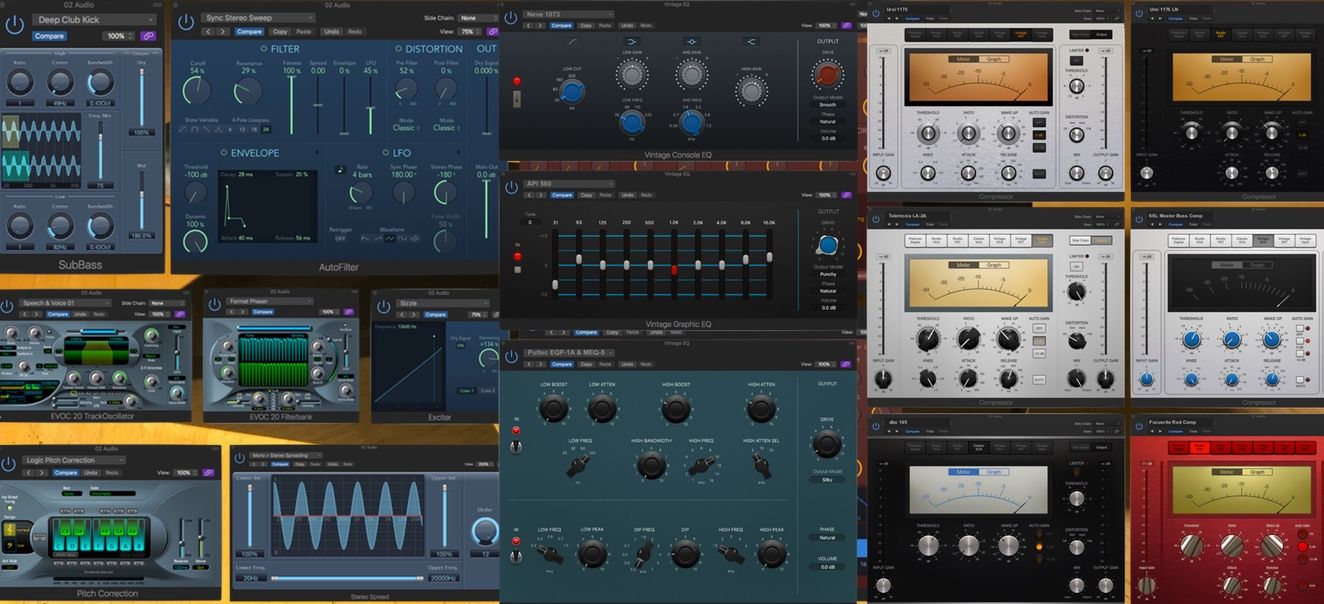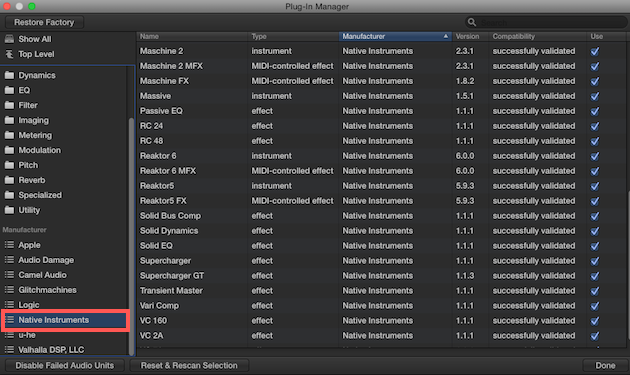VST stands for Virtual Studio Technology and is the term used when referring to instrument or effect plug-ins within a DAW (Digital Audio Workstation) on your computer. For a more detailed explanation of VSTs, please visit this article. You may also hear VST instruments (VSTis) being referred to as samples. Samples usually come in a library. Just like a soundfont vst but instead of just loading a soundfont, you can actually put every.wav or whatever you want on each key you want on your keyboard. And so turn it into a sort of launchpad. It's a VST but if anyone know a standalone of that kind of stuff it will be very helpful. Logic Pro gives you a massive collection of plug-ins and sounds to fuel your creativity. The ever‑growing Sound Library is also a powerful source of inspiration, thanks to Patches that allow for rich layers of instruments and effects — and Smart Controls that let you easily shape any sound.
- Can You Put A Vst On A Logic Board
- Can You Put A Vst On A Logic Diagram
- Can You Put A Vst On A Logic Book
Mark Goslett is a London-based music producer and member of the Music Producers Guild. His unrelenting pursuit of excellence in the studio, and decades of work as a musician has brought him to the forefront of the music industry, where his credits include: TV commercials, emerging artists, and a profusion of live sound engineering engagements.

Can You Put A Vst On A Logic Board
He’s an expert in Apple’s Logic Pro X software, and in this lesson he teaches you how to install plugins for the first time.
You guessed it: the first thing you’ll need are third-party plugins to install! If you don’t already own some, you can visit Bedroom Producers’ Blog, where you’ll find dozens of free VSTs conveniently organized by category. Of course, Logic is a Mac OS-based DAW, so you’ll need to make sure your plugins are Mac compatible. Luckily these days, nearly every plugin developed is cross-platform.
Once you’ve downloaded your plugins, the next step is to manually install them in the system. When you’ve unzipped the download, you should find your plugin in several different formats, like VST, VST3, and Component. Only Audio Units (.component) plugins are compatible with Logic Pro X.
So, you’ll need to use the Audio Unit (.component) version of the downloaded plugin for installation.
You’ll need to copy the Component plugin file into the plugins folder on your computer. The file path is as follows: Macintosh HD > Library > Audio > Plugins > Components.
Simply drag the file into the components folder, and you will have installed the plugin in your system!
How To Add Plugins In Logic Pro X (Video)
Article Content
Buying plugins is fun.
You can’t deny it. I can’t deny it.
We all like shiny new things.
But herein lies the #1 problem people have with mixing…
Too many choices.
There are just seven plugins that will get you 80% of the way to a professional, studio-level mix.
Sure, the last 20% might require a few new toys…
But until you can get a great mix with just these seven tools, you aren’t ready to enter that world.
It’s a dangerous world, after all. Mixing is all about skill, not gear, and GAS is the main reason why people fail to ever achieve the sound in their head.
If you want to make fast progress, you need to focus on the core tools at your disposal. Master these seven plugins, and you are well on your way to higher quality mixes.
Now, if you want to know exactly what I recommend, I put together a free PDF for you.
Inside, I share my seven specific go-to plugins. Check them out here:
Gain
Let’s get the boring stuff out the way first: gain staging.
This isn’t something you should obsess over. Every track doesn’t need to be exactly -18dBFS. Just aim to have 10dBFS of headroom on most channels.
So, how do you do this? You need a trim plugin in your first slot.
Different DAWs have a different name for this.
- Pro Tools: Trim
- Logic Pro: Gain
- Studio One: Mixtool
- Cubase: Pre Gain (not a plugin, but a feature)
You could also try this free plugin from Sienda.
If the channel looks hot, load up a gain plugin in your first slot and lower the gain until you can see the channel is peaking at roughly -10dBFS. That’s it.
EQ
Now for the fun stuff…
You probably guessed that this would be on the list. After volume balancing, EQ is the most important tool at your disposal.
It’s the only plugin that has the potential to appear on almost every channel, so spend plenty of time learning it.
Compression
After volume balancing and EQ, compression is next in order of importance.
In fact, I’d go as far to say that 80% of the sound of your mix comes from these three things.
For most people, compression is harder to grasp than EQ. But once you really understand how a compressor works, and the incredible versatility of this tool, things really start to fall into place.
Reverb
Up until this point we’ve covered the essentials for creating a balanced mix. Now we can add some additional interest.
Reverb is a hot topic. Over the last couple of decades, it’s played a very supportive role. Delay was at the forefront. But now, it seems reverb is making a comeback.
Either way, this is a crucial plugin in your repertoire. When used subtly, it’s how you create depth, cohesion and space in your mixes. Used liberally, it’s an effective way to add character and help make your mixes sound larger than life.

Delay
The main problem with reverb is that it’s often used as a crutch. Beginners will use reverb to mask mistakes and poor mixes. It’s also easy to make your mixes sound muddy and cluttered with improper use.

That’s where delay comes in. It allows you to create space and depth without filling up the mix and getting in the way.
Whether it’s a stereo slapback delay on the vocal, a timed echo used for emphasis, or a single slapback to move something further back in a mix — this can be an extremely valuable tool.
Limiting
This one only applies if you don’t get your tracks mastered.
Sure, many people use limiters when mixing, but in that context it’s by no means a crucial plugin.
But, if you want to share your music without getting it mastered, a limiter can help make it loud.
Maintain headroom throughout the mix, then load up a limiter as the final plugin on your mix buss or master fader. Set the ceiling to -0.01dB, increase the gain until you see 2-3dB of gain reduction on the louder peaks, and you’re done.
Gating
Most people wouldn’t consider this tool essential. And let me be clear — it’s the least important plugin on this list.
But if you were to reduce your collection to only seven plugins, for the rest of your life, this should be one of them.
Personally, I can’t mix drums without using a gate. And that’s the main use case here. Without using a gate on the kick and snare, I can never get the tone I want for the overall kit.
Perhaps this is a weakness of mine, or perhaps I’m not alone in this. Either way, for me, this is an essential tool.
Bonus: Saturation
Technically, saturation isn’t required to produce a radio-worthy mix. But it will certainly help.
Out of all of the additional tools available to you, saturation is perhaps the most important for taking your mixes from good to great.
For that reason, it felt wrong to leave it off this list.
Focus on These Seven Plugins
There you go — the only seven plugins you need to produce a great sounding mix.

Focus your time and energy learning these core tools, and you’ll be able to produce better mixes than you ever thought possible…
And it could save you years of wasted time in the process.
Can You Put A Vst On A Logic Diagram
But then the question is “which exact plugins should I use for each of these categories of processors?”
Can You Put A Vst On A Logic Book
I can only give you my personal recommendations, after trying hundreds of plugins and narrowing it down to just seven.
Get the complete list below…
The Only 7 Mixing Plugins You’ll Ever Need | Use Best DAW Like a PRO
Buying plugins is fun. You can’t deny it. I can’t deny it. We all like shiny new things. But herein lies the #1 problem people have with mixing… Too many choices. There are just seven plugins that will get you 80% of the way to a professional, studio-level mix. Sure, the last 20% might require a few